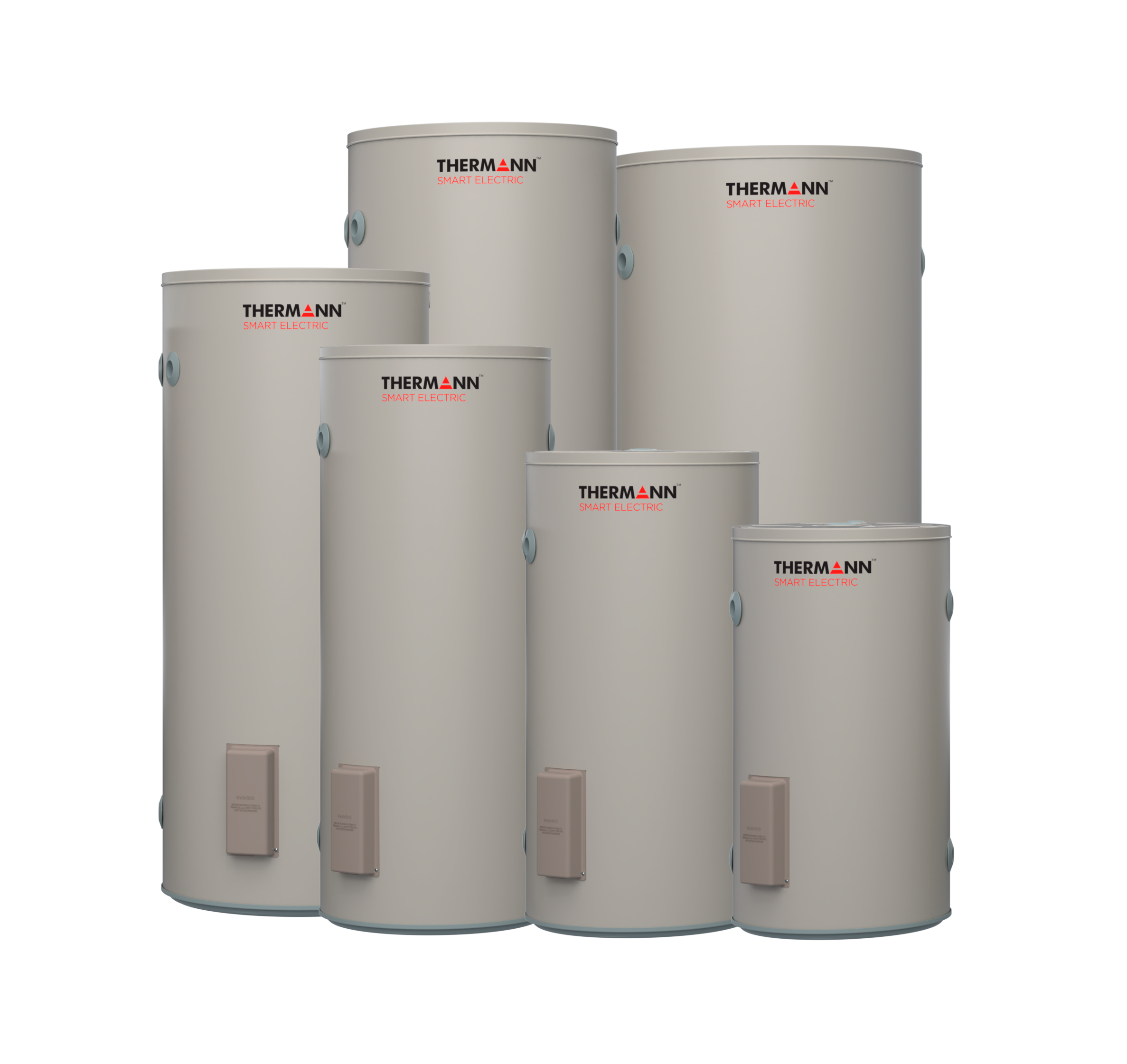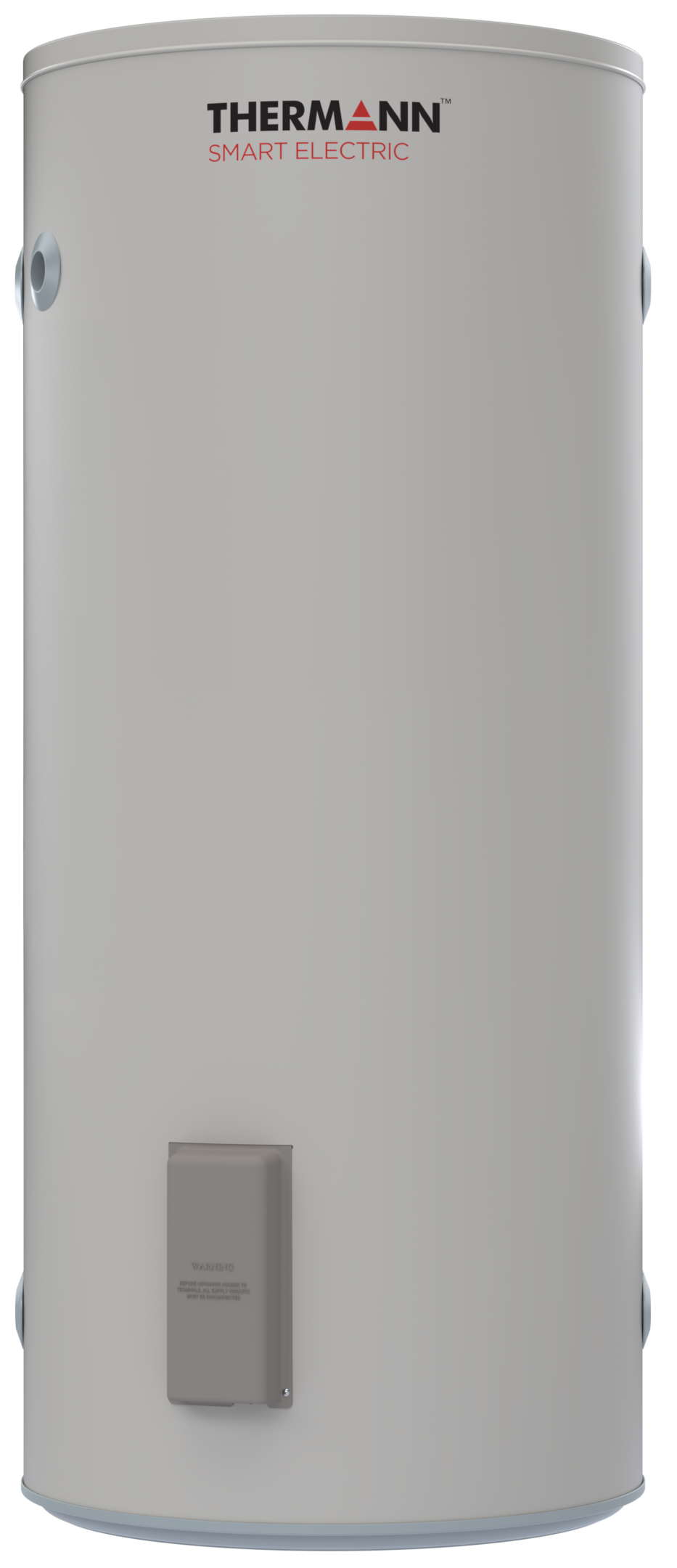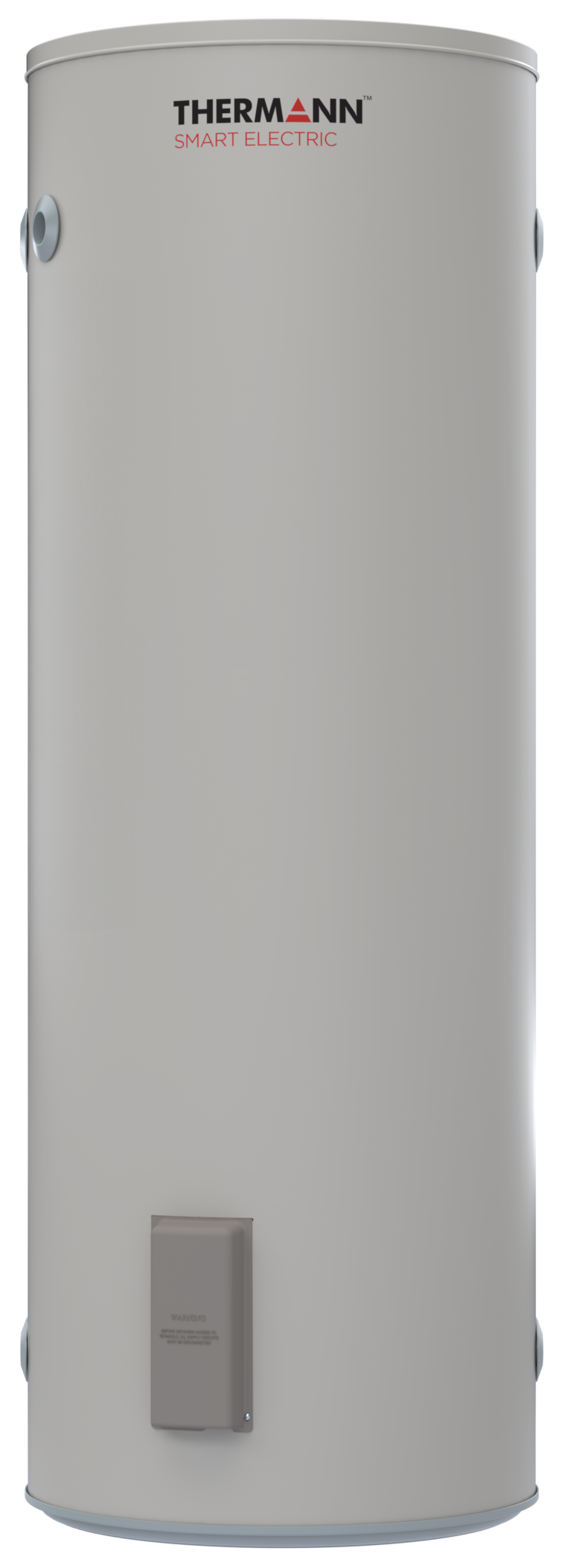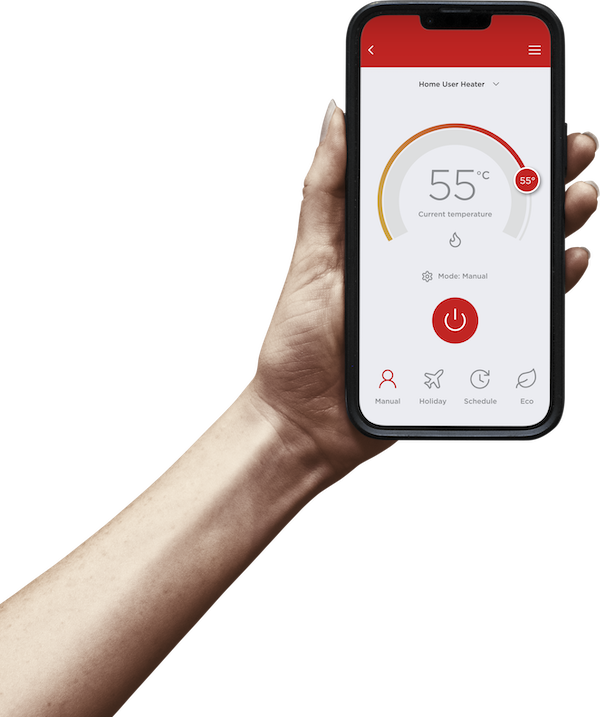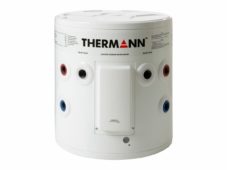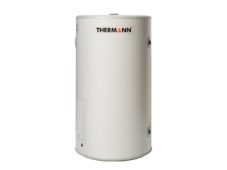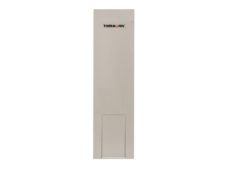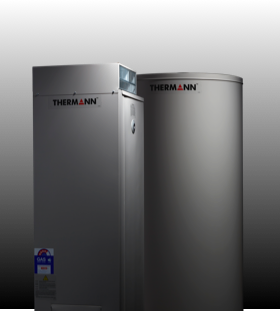-
Smart Electric Storage
Electric · Storage Hot Water Systems
Key Specifications
Fuel typeElectricElement Recovery Rates:1.8kW Element31L/hr @ 50°C2.4kW Element41L/hr @ 50°C3kW Element51.6L/hr @ 50°CHard Water options availableWarranty Information
-
Warranty Information
Domestic Warranty
10 Year Tank
1 Year Parts and Labour3 Years Parts and Labour*
1 Year Other Parts and Labour
*Wifi module, cable, thermostat & element
-
Considerations
Pros
Control when your hot water system heats water to save money.
View energy use and power cost.
Turn system on or off before holidays or when house is vacant.Cons
Additional cost relative to a standard electric water heater.
Relies on a WiFi connection to the water heater. Without WiFi, you can't realise any benefits of the Smart technology.
Resources
App Setup GuideAlways use a licensed plumber when installing a hot water system.
Smart Electric Storage
Electric · Storage Hot Water Systems
The Thermann Smart Electric gives you more control over your hot water, energy use, and power bill with our new app-enhanced electric range.
- View your energy use and power cost at a glance
- Save money on your hot water bills by controlling when your hot water system heats water, reducing energy usage by not heating water unnecessarily.
-
Choose from four operating modes —
- Manual Mode: Lower tank temperature to maximise savings, while keeping anti-legionella cycle.
- Eco Mode: Machine learning can analyze usage patterns and adjust the heating cycle to reduce energy use by keeping heating to a minimum.
- Holiday Mode: Remotely turn your hot water system on or off before holidays or when the house is vacant.
- Schedule Mode: Adjust the hot water system to operate more efficiently around your home's unique schedule.
Use our online optimiser tool to find out which mode is recommended for you.Important Note: The tank must be filled with water prior to connecting to a power source
How it works
1. A hot water tap is turned on
2. Hot water is drawn from the top of the tank
3. Cold water enters through the bottom of the tank
4. When water temperature around the element drops, element activates
5. Hot water rises to the top of the tank
6. Control when the unit heats water to optimise functionality and save you money with the Thermann Control App

Frequently Asked Questions
-
Why can’t I connect my hot water unit to the app?
First, check you are connected to your home WiFi when standing next to your Smart Electric unit. Once connected, turn your hot water unit off and then on again to restart the pairing mode which will remain active for 5 minutes. If you cannot pair within this time, start again by turning your unit off and then back on.
Check that your password credentials are correct, especially when using an extender (both passwords need to match). Special symbols and characters in your password may cause an issue with connecting to the water heater.
If you’ve replaced a water heater previously connected to a controlled load i.e. off-peak tariff, ensure that power is available to the water heater. Without power, you won’t be able to connect to the water heater. We’d suggest changing your tariff to a continuous supply in this situation.
For more help, check out our App How-To video.
-
What mode should I use?
Use our Smart Electric Optimisation tool to find out which operating mode will be best for you and your hot water needs.
-
I’ve scheduled the water heater to heat, but it’s not
working properly.
Other than interrupted power supply to the water heater e.g. relating to an off-peak tariff connection, check that the schedule is set across a 24 hour period (and not just 12 hours), and that a schedule is set for each day of the week. The app won’t copy across the schedule to other days, they need to be set for each day of the week.
-
How do I connect another device to my Smart Electric
unit?
You can use the Thermann Control app on a second device. A new account will need to be created on this new device. To set this up, go to ‘settings’ on the primary device, and select ‘Manage Water Heater’. Select ‘Share’ next to the water heater you wish to share and a QR code will appear on the screen of your primary device which can be scanned by the secondary device to establish a connection.
Please note, by sharing connection to a new device, you are giving consent for that device to manage your hot water unit. For more information on Access Sharing, click here.
-
Can I create a hotspot to connect to the water
heater?
Yes, however this is only a temporary solution. Through the hotspot you will be able to configure and save the settings and schedules for the water heater, however, remote monitoring and management of the water heater is subjected to availability of mobile data and Wi-Fi hotspot network connection (2.4GHz bandwidth) from the secondary device.
See instructions in the Owners Guide for establishing a hotspot.
-
I’m getting notified that the water heater is doing an
antibacterial cycle. What is this?
The antibacterial cycle is to prevent legionella formation in the water. The cycle is triggered to heat the stored water to 62°C for 32 minutes every 7 days if the stored water temperature is set below 62°C.
-
The temperature of the water heater in the app drops
dramatically after I have a shower. Is this unit
faulty?
No. The thermostat for the product is based low in the tank, close to the cold water inlet. When hot water is used, cold water enters the tank and it’s this temperature that the app then shows. Once the water in the tank mixes and settles, you’ll see the temperature on the app read higher again.
-
Can I connect my Smart Electric water heater to the 5G
network?
No. The product is only designed for connection to a 2.4GHz network.
-
What if I can’t access my home WiFi when standing next
to the Hot Water System?
If you cannot receive WiFi connection when standing next to your hot water system, a WiFi extender may help. Don’t worry if you cannot set up your Thermann Control App upon install, your unit will still run just like a standard electric storage unit and you can set up your App connectivity at a later date.
-
-
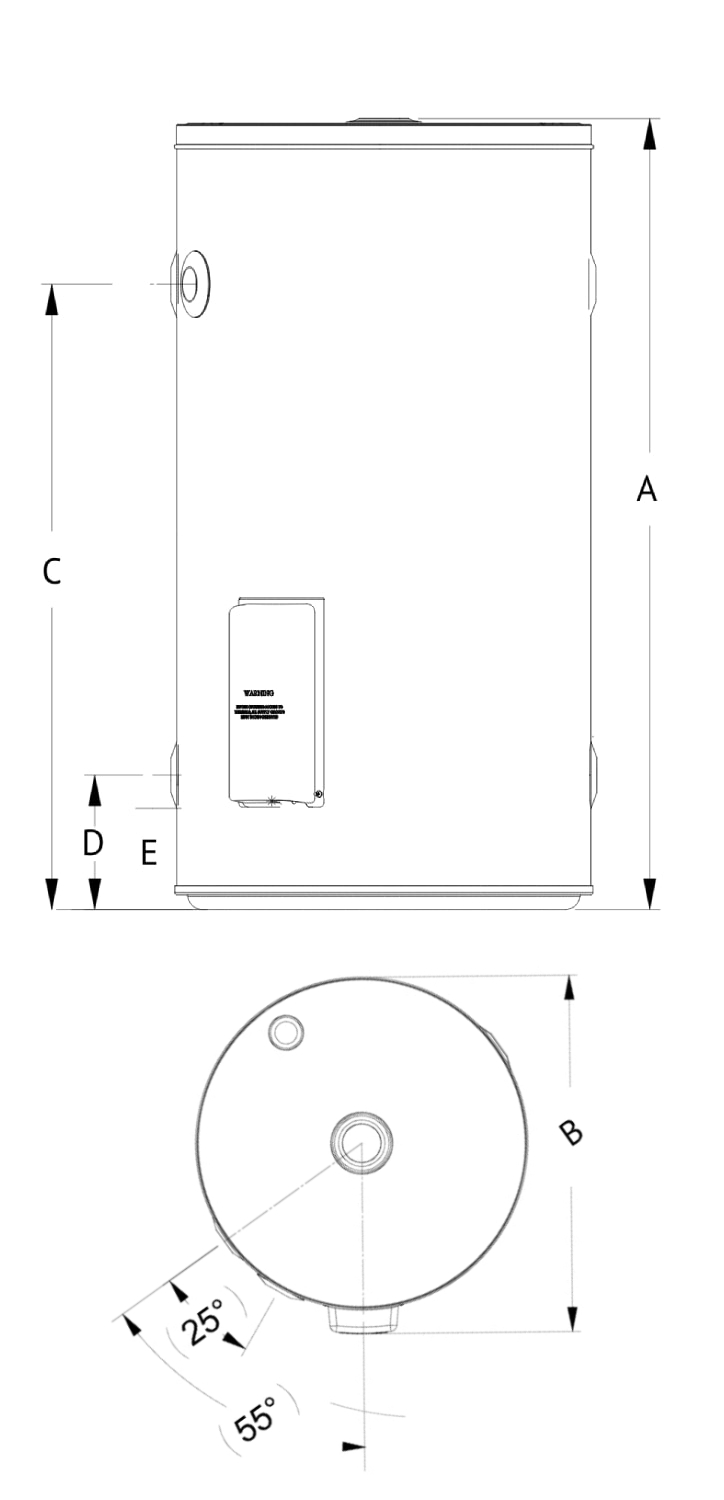
Measurements 80L 125L 160L 250L 315L 400L Total Height (A) 925 1090 1315 1445 1765 1705 Total Diameter (B) 490 530 530 620 620 705 Outlet Height (C) 735 865 1095 1220 1530 1445 Inlet Height (D) 160 190 190 195 195 220 Electrical Entry (E) 126 135 135 140 143 168 Element Angle (K) 90° 90° 90° 90° 90° 90° Storage Capacity (L) 88 130 161 259 321 415 Hot Water Delivery (L) 80 125 160 250 315 400 Net Weight Empty (kg) 41 51 59 72 93 115 No. of elements Single Single Single Single Single Single Element Sizes (kW) 1.8
2.4
3.01.8
2.4
3.01.8
2.4
3.01.8
2.4
3.01.8
2.4
3.0-
2.4
3.0Relief Valve Pressure (kPa) 1000 1000 1000 1000 1000 1000 Relief Valve Temperature (°C) 99 99 99 99 99 99 Power Rating (kW) 10 10 10 10 10 10 Inlet/Outlet Dual Hand Dual Hand Dual Hand Dual Hand Dual Hand Dual Hand No. People (continuous) 2-3 3-4 3-5 3-5 4-6 5-9 No People (off peak) 2 3 1-3 1-3 2-4 4-6 -
Product code Capacity No. People
(continuous)No People
(off peak)Element Size Option 1361434 80L 2-3 2 1.8 - 1361437 80L 2-3 2 1.8 Hard water 1361435 80L 2-3 2 2.4 - 1361438 80L 2-3 2 2.4 Hard water 1361436 80L 2-3 2 3.0 - 1361439 80L 2-3 2 3.0 Hard water 1361440 125L 3-4 3 1.8 - 1361443 125L 3-4 3 1.8 Hard water 1361441 125L 3-4 3 2.4 - 1361444 125L 3-4 3 2.4 Hard water 1361442 125L 3-4 3 3.0 - 1361445 125L 3-4 3 3.0 Hard water 1361446 160L 3-5 1-3 1.8 - 1361449 160L 3-5 1-3 1.8 Hard water 1361447 160L 3-5 1-3 2.4 - 1361450 160L 3-5 1-3 2.4 Hard water 1361448 160L 3-5 1-3 3.0 - 1361451 160L 3-5 1-3 3.0 Hard water 1361452 250L 3-5 1-3 1.8 - 1361453 250L 3-5 1-3 1.8 Hard water 1366182 250L 3-5 1-3 2.4 - 1366331 250L 3-5 1-3 2.4 Hard water 1366184 250L 3-5 1-3 3.0 - 1366333 250L 3-5 1-3 3.0 Hard water 1361454 315L 4-6 2-4 1.8 - 1361455 315L 4-6 2-4 1.8 Hard water 1366183 315L 4-6 2-4 2.4 - 1366332 315L 4-6 2-4 2.4 Hard water 1366185 315L 4-6 2-4 3.0 - 1366334 315L 4-6 2-4 3.0 Hard water 1361456 400L 5-9 4-6 2.4 - 1361458 400L 5-9 4-6 2.4 Hard water 1361457 400L 5-9 4-6 3.0 - 1361459 400L 5-9 4-6 3.0 Hard water
Comparison disclaimer
These are comparative figures that indicate the estimated savings that can be made by replacing a standard electric water heater with a smart electric water heater in the two following scenarios; (1) Household with a PV system fitted; (2) Household connected to a Time-of-Use (TOU) tariff. The amount of electricity used to operate the water heater for one year is calculated based on hot water usage and weather data conditions as specified in Australian/New Zealand Standard AS/NZS 4234 for a 4-person household based in Zone 3. Data displayed represents the savings achieved when comparing the Thermann Smart Electric 3.0kW, 315L model with the reference water heater. (1) Savings of up to $1000 for households with PV rely on at least 3kW of excess power being available between the hours of 10am and 3pm, using a single tariff rate of 35c per kWh, and a Feed in tariff (FiT) of 7c per kWh. (2) Savings of up to $650 for households with a TOU tariff, when the water heater is timed to heat during off-peak tariff periods versus peak tariff periods, assuming a controlled (off-peak) tariff rate of 20c per kWh, and a peak tariff rate of 35c per kWh.


